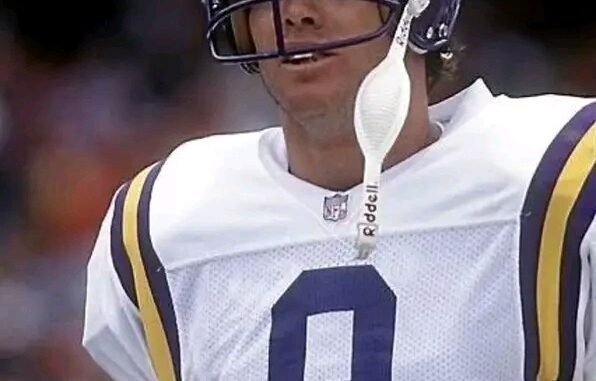
NFL Legends Jim McMahon and Tommy Kramer: Quarterbacks of Grit, Legacy, and Resilience
In the rich tapestry of National Football League history, certain players leave an indelible mark not just through records and championships, but through their unmistakable grit, leadership, and personalities that transcend the game. Jim McMahon and Tommy Kramer are two such quarterbacks—tough, charismatic, and resilient men whose careers captured the spirit of their teams and the era they played in. Though their paths diverged in many ways, they remain tied by their roles as leaders under center, their stints with the Minnesota Vikings, and the health challenges they face post-retirement.
Jim McMahon: The Rebel Who Won Big
Jim McMahon, born on August 21, 1959, emerged as one of the most colorful and controversial figures in NFL history. Best remembered as the quarterback who led the Chicago Bears to their only Super Bowl victory in January 1986, McMahon’s journey to NFL stardom was anything but conventional.
After a standout college career at BYU, where he rewrote record books with his strong arm and competitive fire, McMahon was drafted fifth overall by the Bears in 1982. From the beginning, he stood out—not just for his play, but for his attitude. Known for wearing headbands in defiance of league dress codes and for speaking his mind, McMahon quickly became a fan favorite and a locker room leader.
Under head coach Mike Ditka and behind a ferocious defense led by Mike Singletary, McMahon was the offensive spark that powered the 1985 Bears to a legendary season. With a 15-1 regular season record, the team steamrolled through the playoffs and dismantled the New England Patriots 46-10 in Super Bowl XX. McMahon threw for over 2,300 yards and 15 touchdowns that season and, perhaps more importantly, injected the offense with confidence and edge.
Though he would never replicate that level of team success, McMahon’s career extended across 15 seasons. He played for the San Diego Chargers, Philadelphia Eagles, Arizona Cardinals, Cleveland Browns, Minnesota Vikings (in 1993), and eventually backed up Brett Favre with the Green Bay Packers, earning another Super Bowl ring in 1996.
Injuries plagued much of his career—particularly concussions and shoulder issues—but McMahon remained a fearless competitor until the end. His battles on the field mirrored his battles off it in retirement, as he became a vocal advocate for concussion awareness and treatment for retired players. He has publicly struggled with early-onset dementia symptoms and has credited chiropractic and alternative therapies with helping relieve symptoms caused by spinal misalignment.
Tommy Kramer: The Vikings’ “Two-Minute Tommy”
Tommy Kramer, another quarterback cut from the cloth of tenacity and talent, was the face of the Minnesota Vikings for much of the late 1970s and 1980s. Born on March 7, 1955, Kramer played college football at Rice University, where he earned the nickname “Two-Minute Tommy” for his clutch performances in late-game situations.
Drafted in the first round by the Vikings in 1977, Kramer inherited the pressure of following Fran Tarkenton, a Hall of Famer and Vikings legend. While injuries and inconsistency often hampered his career, Kramer showed flashes of brilliance. He could stretch the field with his arm and rally the team in pressure moments—his late-game heroics became a hallmark of his style.
Kramer’s best season came in 1986 when he threw for 3,000 yards and 24 touchdowns, earning Pro Bowl honors. Yet like McMahon, injuries haunted his career, particularly to his knees and back. He played 13 seasons in the NFL—12 with the Vikings and one final season with the New Orleans Saints in 1990.
While he never led Minnesota to a Super Bowl appearance, he remains beloved among Vikings fans for his toughness, flair, and loyalty to the team during a period of transition. His on-field leadership made him a Viking through and through.
Shared Legacies and Struggles
Both McMahon and Kramer epitomized the rugged quarterback archetype of the 1980s—gritty, daring, and always willing to take a hit to make a play. They shared a deep understanding of the physical toll the game took, something that has become more evident as they’ve aged.
Kramer, like McMahon, has been diagnosed with dementia, a condition increasingly common among former NFL players. The long-term effects of repeated head trauma have become a pressing issue in the league and have led to increased scrutiny of player safety and concussion protocols. Kramer has spoken publicly about his struggles and has joined other former players in raising awareness about the need for better post-career medical support.
McMahon, meanwhile, has participated in documentaries and interviews where he has discussed not only his cognitive issues but the depression and disorientation he experienced due to brain injuries. His advocacy work, including his involvement in the 2011 concussion lawsuit settlement with the NFL, has made him a leading voice in pushing for change in how the league treats its retired players.
Despite their battles, both men have maintained a sense of humor and dignity that reflect the strength they showed as players. Kramer is known for engaging with fans on social media, often sharing stories from his playing days. McMahon, always the maverick, continues to live life on his own terms—often seen wearing his Super Bowl ring from the Packers just to needle Bears fans.
Conclusion
Jim McMahon and Tommy Kramer were quarterbacks who defined an era—not necessarily through gaudy stats or flawless technique, but through their fire, leadership, and courage to play the game the hard way. Their stories are reminders of football’s glory and its cost. As they continue to battle the lasting effects of their careers, their contributions to the sport endure. They were not just quarterbacks; they were warriors under center, respected by teammates, feared by opponents, and now, admired for their resilience in life after football.
Let me know if you’d like this formatted as a magazine feature, news article, or expanded with quotes and stats!
Leave a Reply